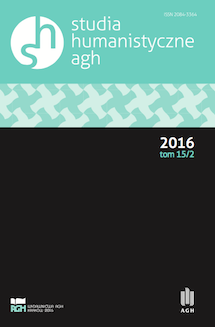MIĘDZY DYSTOPIĄ A UTOPIĄ: FUTURYSTYCZNA WIZJA ŚWIATA W FILMIE CHRISTOPHERA NOLANA INTERSTELLAR (2014)
BETWEEN THE WASTE LAND AND NO PLACE: CHRISTOPHER NOLAN’S FUTURISTIC DYSTOPIA INTERSTELLAR (2014)
Author(s): Patrycja PodgajnaSubject(s): Fiction, Social Philosophy, Social development, Environmental interactions, Film / Cinema / Cinematography, Globalization
Published by: Wydawnictwa AGH
Keywords: dystopia; global catastrophe; ecology; space; books; utopia;
Summary/Abstract: Since the 1990s the number of dystopian films projecting apocalyptic visions of global catastrophe and dramatising an ecological agenda has radically increased. Much of this trend is inspired by anxieties about the future repercussions of today’s actions and the collective responsibility for the future of our planet. One film that aptly represents this category is Christopher Nolan’s futuristic dystopia Interstellar (2014). Blending generic conventions of space-travel, science-fiction and moral fable, the film, with its bleak vision of ecological disaster, social unrest, and economic decline, clearly evokes the dystopian paradigm in which the projected reality is perceived as significantly worse than the here and now (sensu Sargent 1994:5). However, contrary to many dystopias offering nihilistic or anti-utopian denouements, Christopher Nolan’s apocalyptic vision clearly posits a progressive and definite possibility of utopian impulse, which is encapsulated by the final resolution of the global catastrophe. The core of the argument is that the neutralization of the dystopian impulse and the resulting projection of the utopian vision are facilitated by the imposition of an interstitial space constructed in the vein of postmodern poetics: an ambiguous fifth dimensional library, in which books perform a two-fold function. While intratextually, they serve as a catalyst between the tangibly dystopian present and the possibly utopian future, extratextually, they function as a universal mode of communication transcending the constraints of time and space.
Journal: Studia Humanistyczne AGH
- Issue Year: 15/2016
- Issue No: 2
- Page Range: 51-56
- Page Count: 6
- Language: English

